Overview
This article offers a compassionate overview of a variety of free autism activities designed to engage children with developmental differences. It highlights the importance of these activities—ranging from art and music to outdoor experiences and technology-based tools—in fostering essential skills such as social interaction, communication, and emotional regulation. By nurturing these skills, we can promote overall development and well-being for our children.
As parents, we understand the challenges that come with supporting a child on the autism spectrum. These activities not only provide enjoyment but also serve as valuable tools for growth. Imagine your child expressing themselves through art or connecting with others in a supportive outdoor setting. These moments can be transformative, helping to build confidence and social skills.
We encourage you to explore these activities and consider how they can fit into your child's routine. By integrating fun and engaging experiences, we can create opportunities for learning and connection. Join us in this journey to support our children’s development and well-being, and feel free to share your experiences or questions in the comments. Together, we can foster a nurturing environment where every child can thrive.
Introduction
In a world where understanding and supporting children with autism is more crucial than ever, a wealth of resources and activities are emerging to enhance engagement and development. Imagine a space filled with interactive virtual learning games and sensory-friendly outdoor experiences, where organizations like ASD Media, Autism Speaks, and the Autism Society are paving the way for innovative approaches that cater to the unique needs of children on the spectrum.
These initiatives not only foster essential skills such as communication and social interaction but also promote creativity and self-expression through art, music, and theater. As families navigate the complexities of autism, these diverse activities offer invaluable support, empowering both parents and children to thrive in a nurturing and inclusive environment.
Have you explored these resources yet? They could make a significant difference in your journey.
About ASD Media: Resources for Engaging Autism Activities
At ASD Media, we are deeply committed to enhancing the application of ABA therapy by offering a comprehensive array of resources designed to engage children with developmental disorders. Our platform provides invaluable insights into effective strategies that help overcome challenges and improve outcomes, making it an essential tool for both parents and professionals. Did you know that a remarkable 78.8% of school-age individuals with autism excel in at least one developmental area by middle childhood? This statistic highlights the incredible potential for positive growth through targeted interventions.
We understand that the average cost of therapeutic behavioral services in the U.S. is $175.44, which underscores the financial considerations parents face when seeking support. By fostering a nurturing community, ASD Media empowers individuals to share their experiences and learn from one another, ensuring access to best practices in free autism activities. Furthermore, case studies, such as the assistance provided by Prospera Healthcare, illustrate how tailored support from Board-Certified Behavior Analysts (BCBAs) can help families navigate the complexities of treatment, ultimately promoting advancement and development for their children.
This collaborative approach not only enhances personal outcomes but also strengthens community ties, which are vital for effective engagement. Additionally, as highlighted by Yolande Loftus, disparities in ASD prevalence among various racial groups call for inclusive resources that cater to diverse communities. Recognizing that ASD is a developmental disorder that can lead to significant social, communication, and behavioral challenges highlights the importance of free autism activities and resources for children with this condition. By connecting parents with actionable tips and community support, ASD Media plays a crucial role in empowering families on their journey. We invite you to join our community, share your experiences, and access the resources that can make a difference in your child's life.
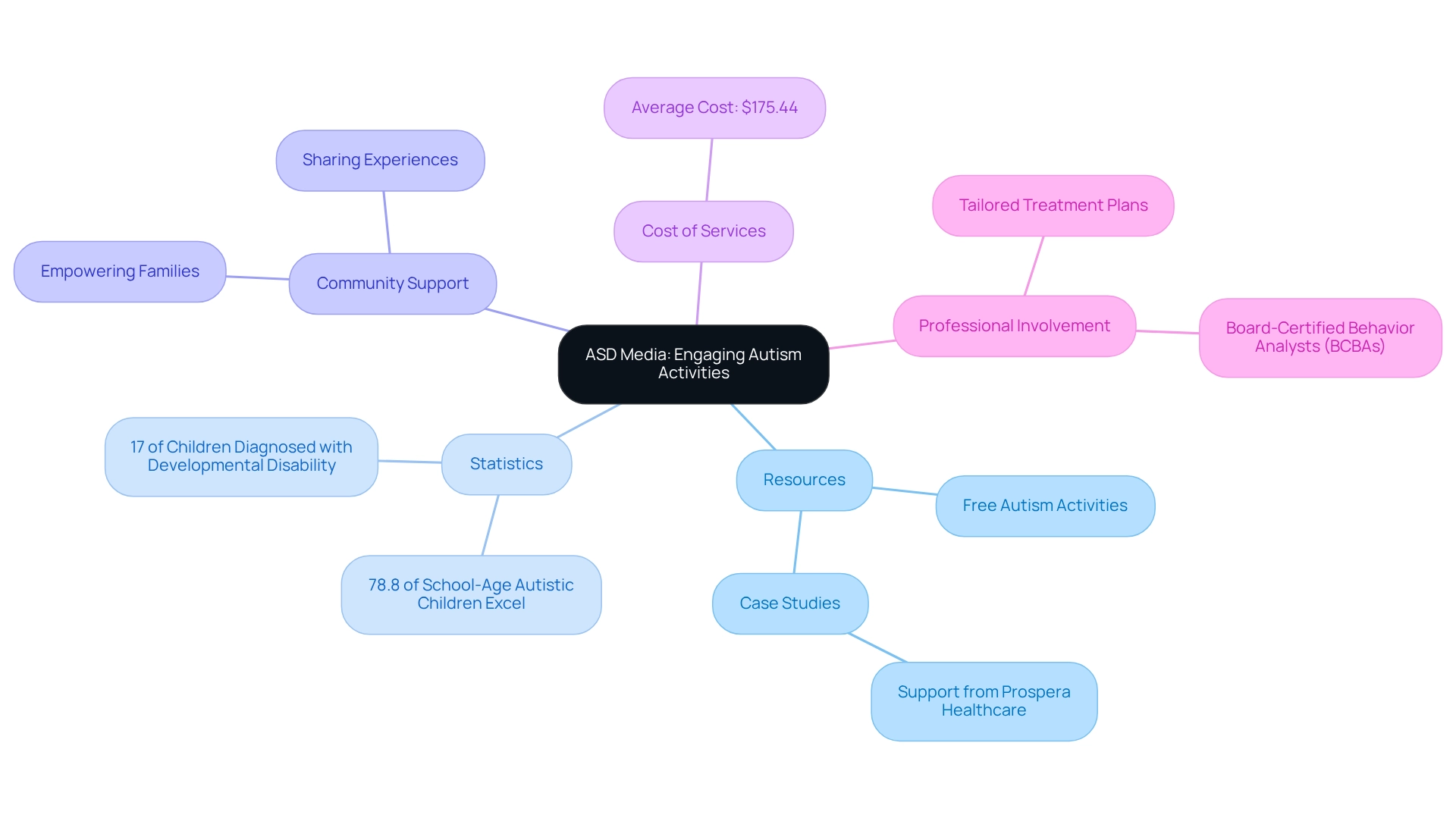
Autism Speaks: Virtual Interactive Activities for Kids
Autism Speaks offers a diverse array of free autism activities through virtual interactive experiences tailored for children with autism. These offerings include engaging learning games, creative art and crafting sessions, dynamic movement exercises, and free autism activities to enhance the experience. Such free autism activities not only promote physical well-being but also enhance social skills, making them essential for growth. By harnessing technology, Autism Speaks allows young individuals to participate in enriching experiences from the comfort of their homes, enabling families to effortlessly weave enjoyable learning into their daily lives.
Current trends indicate a growing reliance on digital resources, with many parents expressing that these tools significantly boost their children's involvement and educational outcomes. Research highlights that 36.5% of caregivers for individuals with developmental disorders utilize ABA therapy, underscoring the importance of effective virtual activities in fostering engagement and interaction. For parents who often feel overwhelmed by the myriad of treatment options, these virtual resources, which include free autism activities, can be a lifeline, providing structured and enjoyable learning experiences. Insights from the case study 'The Power of Words in Advocacy for Individuals with Autism Spectrum Disorder' further illustrate how thoughtful language can inspire change and foster acceptance. This reinforces the role of virtual engagements in enhancing the educational journey for young individuals with developmental disorders. As we near 2025, the effectiveness of these virtual interactive experiences is validated by numerous case studies, showcasing their significant impact on the educational paths of children with developmental differences. Expert testimonials from Autism Speaks also highlight the positive outcomes linked to these innovative learning tools, encouraging families to explore these valuable resources.
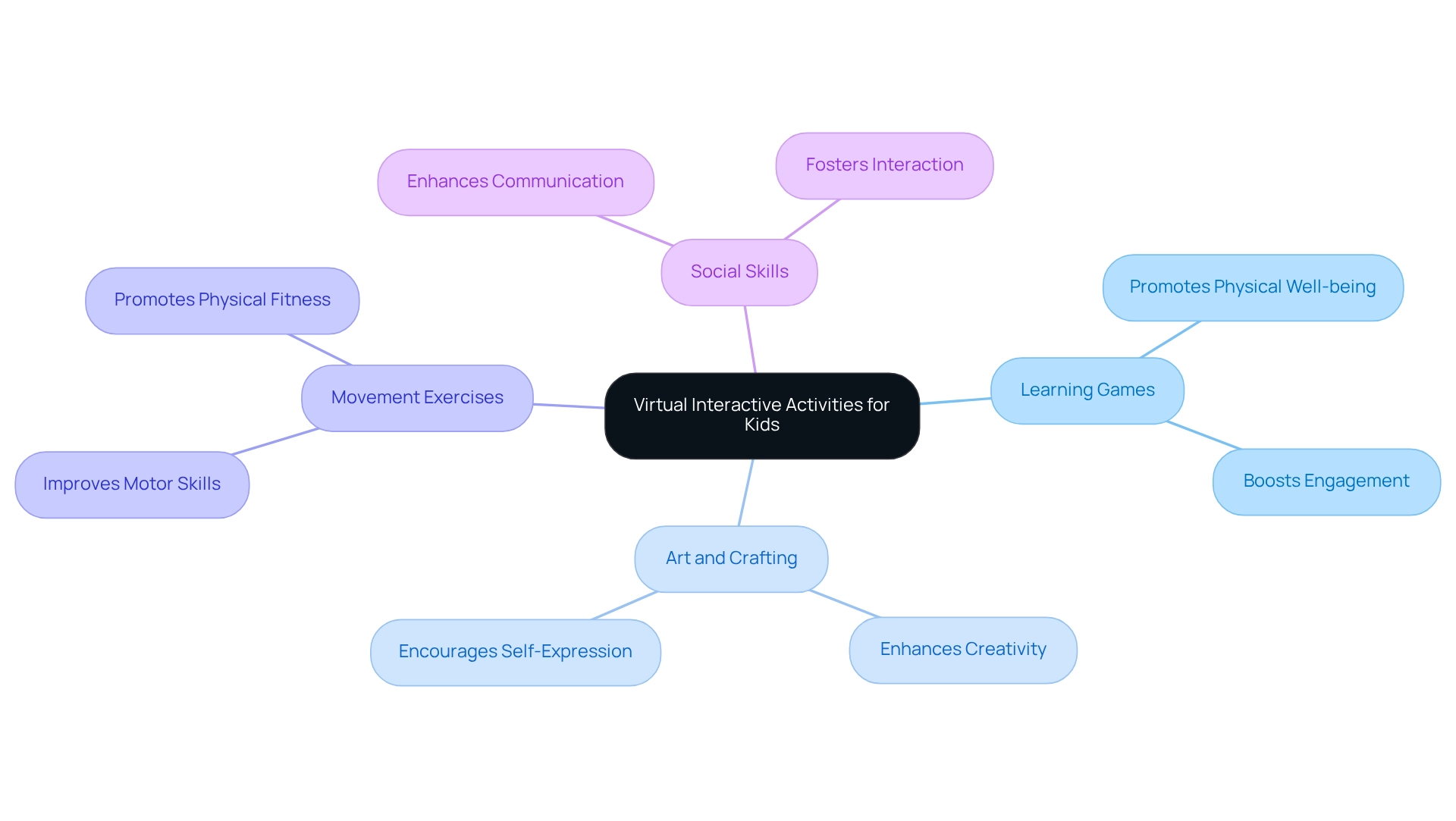
Autism Society of Maryland: Sensory-Friendly Activities and Events
The Autism Society of Maryland plays a vital role in coordinating sensory-friendly events tailored to the unique needs of children on the autism spectrum. These thoughtfully designed events create an inclusive atmosphere, allowing young participants to engage in various activities without the stress of sensory overload. From art workshops to nature excursions, each activity is crafted to enhance social skills and build self-confidence in a nurturing environment.
Research shows that participation in such sensory-friendly events can significantly improve social skills development, as children learn to interact with peers in a comfortable space. Additionally, case studies reveal that these experiences not only encourage social engagement but also inspire long-term involvement in community initiatives, ultimately enriching the lives of individuals with autism.
As we look ahead to 2025, the Autism Society of Maryland is committed to expanding its offerings, ensuring families have access to meaningful experiences that support their children's growth and development. It's worth noting that recruitment for these initiatives received partial support from the Intellectual and Developmental Disabilities Research Center (P30HD03110), highlighting the power of collaboration in enhancing community resources.
Furthermore, findings from the research titled 'Future Directions for Research on Sensory Features and Participation in Tasks' emphasize the need for targeted interventions to maximize the benefits of these engagements. As Joan Smyth, Chair of the Women’s Fund, expresses, 'It is the perfect milestone for the Community Foundation to highlight some of the work we do through the Women’s Fund and the UK Tampon Tax Community Fund,' underscoring the critical role of community support in these vital initiatives.
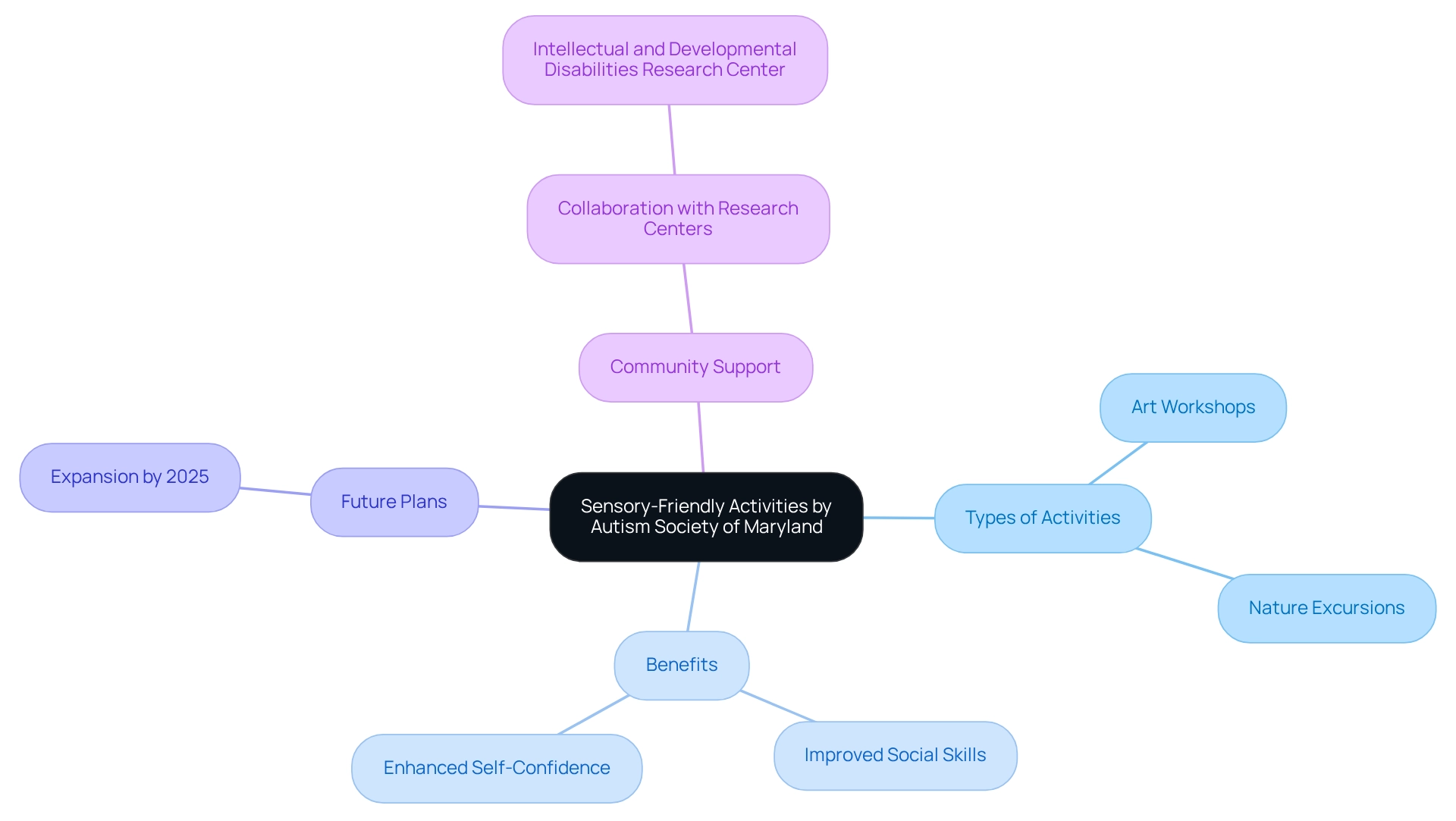
HelpGuide: Art and Crafting Activities for Autism Engagement
HelpGuide offers a variety of free autism activities, including art and crafting activities specifically designed for children with developmental differences. These endeavors not only encourage creativity and self-expression but also significantly enhance fine motor skills. Engaging in free autism activities like painting, sculpting, and collage-making allows young individuals to explore their artistic talents in a structured environment that promotes enjoyment and personal growth.
Research indicates that imaginative pursuits can foster increased engagement and social interaction among young people on the spectrum. Successful art programs, like those highlighted in the case study 'Embracing Neurodiversity,' demonstrate that youth who participate in creative expression show notable improvements in emotional regulation and communication skills. As O. Ivar Lovaas wisely noted, 'If they can't learn the way we teach, we teach the way they learn.' This underscores the importance of adapting learning methods to meet individual needs.
Moreover, Chi-Ying Li emphasizes the value of imaginative activities, stating that they can greatly enhance developmental outcomes for children with developmental disorders. By incorporating art into therapeutic approaches, parents and professionals can uncover new avenues for growth and connection, ultimately enriching the lives of young individuals with developmental differences. We invite you to explore these creative opportunities and consider how they might benefit your child.
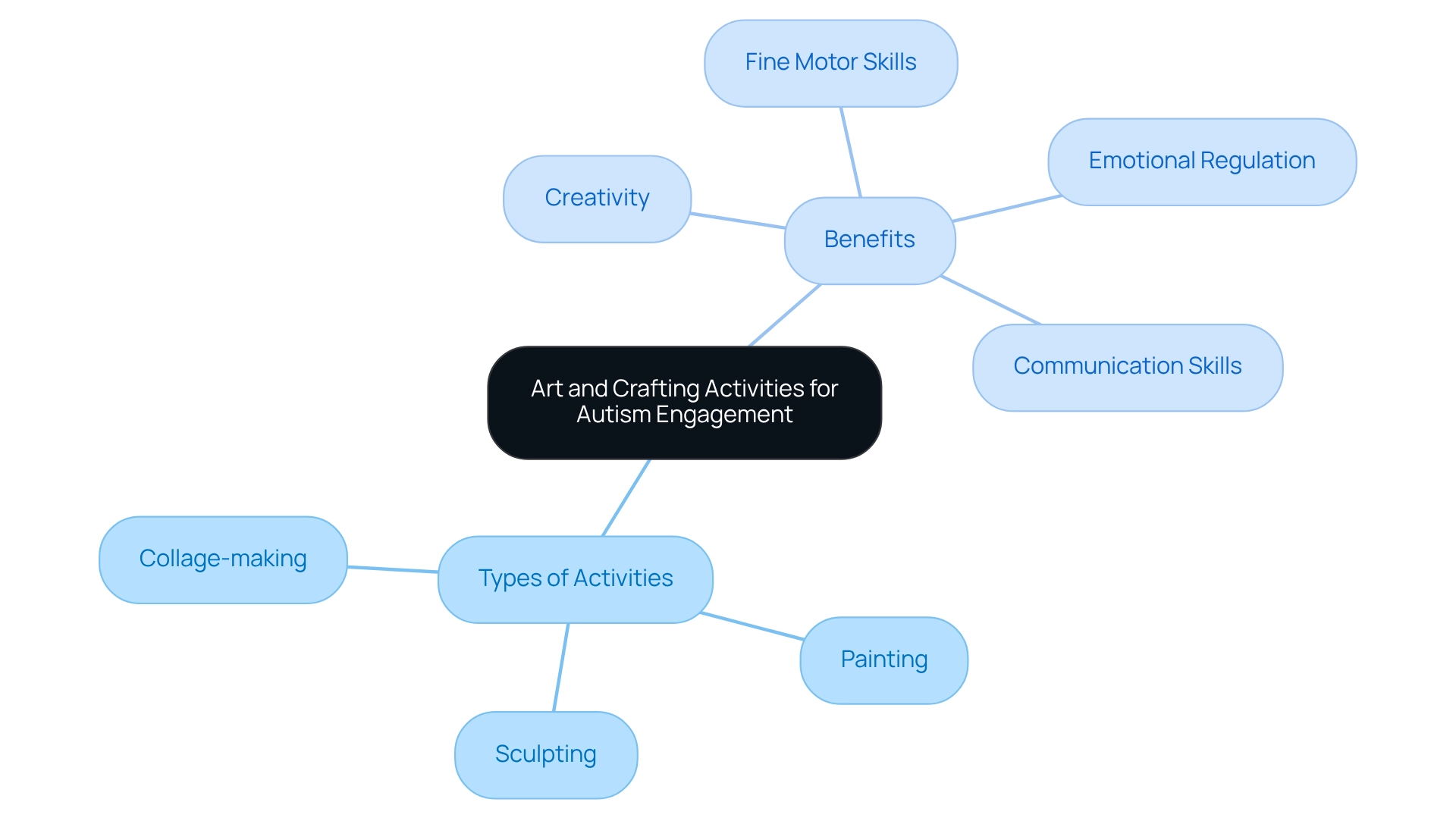
Autism Society: Outdoor and Animal Activities for Engagement
The Autism Society promotes free autism activities that encourage outdoor and animal experiences, enabling young individuals to connect with nature while engaging in physical play. Imagine your child enjoying free autism activities such as:
- Hiking through a forest
- Visiting a petting zoo
- Participating in community gardening
These free autism activities not only provide enriching sensory experiences but also foster vital social interactions. Research shows that free autism activities, particularly outdoor activities, significantly enhance social development among children with developmental disorders. Studies reveal that nature-based experiences can lead to improved communication and relationship-building skills.
Moreover, recreational therapy has proven to enhance overall well-being and quality of life for individuals with developmental disorders. Tailored interventions in recreational therapy effectively address challenges such as communication difficulties and sensory aversions, resulting in a better quality of life and improved social skills. Interacting with animals can create emotional bonds and alleviate anxiety, making these experiences particularly beneficial for children on the spectrum, especially when included in free autism activities like community gardening initiatives that illustrate how nature-focused endeavors can provide young individuals with opportunities to learn, grow, and interact in nurturing environments.
These activities highlight the importance of creating supportive settings where young individuals with developmental disorders can thrive. By embracing these experiences, we can help our children flourish in ways that resonate deeply with their needs and aspirations.

Sesame Workshop: Music Activities for Children with Autism
Sesame Workshop offers a diverse range of music experiences thoughtfully designed for children with autism. These engaging activities include:
- Sing-alongs
- Rhythm games
- Interactive music sessions
These activities not only promote joy but also nurture essential language skills and emotional awareness. Research shows that music therapy is known to enhance self-esteem and inspire creativity in individuals with Autism Spectrum Disorder (ASD). For instance, a study on music therapy highlighted its success in improving social interactions and communication skills among children with ASD, suggesting that these activities can be a valuable complement to traditional therapeutic approaches.
Zhaowen Zhou noted, "This research indicates that MT could effectively enhance the social abilities of youngsters with ASD, and has a beneficial impact on language proficiency." By weaving music into daily routines, parents can create enriching environments that support their children's growth and development. This makes such practices an essential part of engagement strategies moving into 2025.
Looking ahead, future studies should focus on the mechanisms of music therapy and its enduring benefits for individuals with ASD, further underscoring the significance of these practices. We encourage parents to explore these music experiences and share their thoughts and stories, fostering a supportive community around this important topic.
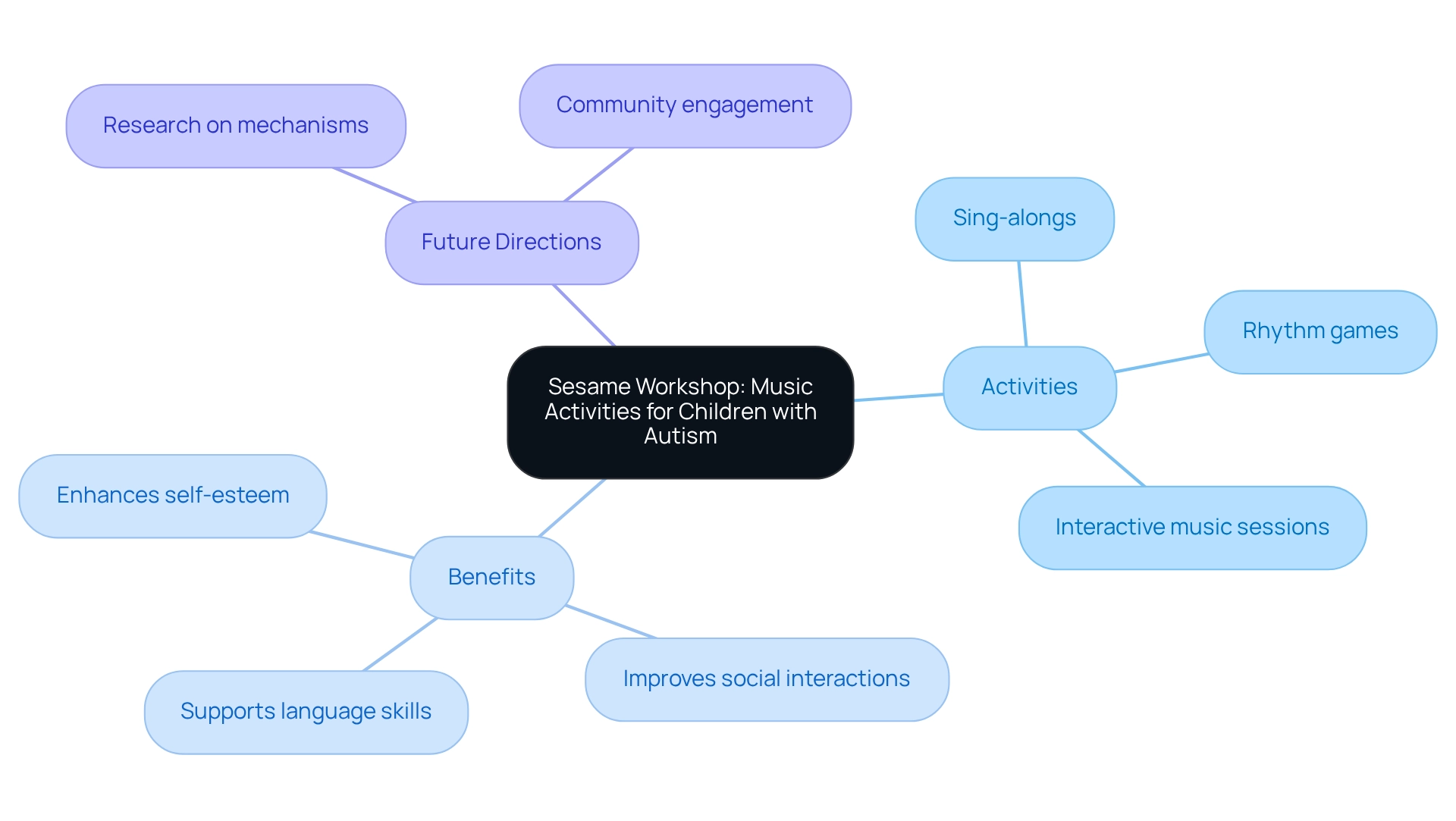
Autism Speaks: Movement and Mindfulness Activities
Movement and mindfulness practices play a crucial role in helping young individuals with developmental disorders develop essential self-regulation skills. By engaging in activities like yoga, guided breathing exercises, and simple stretching routines, children can not only find relaxation but also enhance their focus and emotional regulation. Specific yoga poses, such as:
- Downward-Facing Dog
- Warrior Poses
- Corpse Pose
- Seated Poses
have shown to be particularly beneficial. These poses foster strength and stability while accommodating various abilities, making them accessible to all.
These practices are effective in managing anxiety and improving overall well-being. Research indicates that yoga and mindfulness can significantly reduce anxiety levels in children with autism. Remarkably, those who participate in mindfulness-based programs demonstrate notable improvements in social skills and communication. This highlights the importance of integrating these practices into their daily lives.
As families and professionals explore these resources, it is vital to prioritize evidence-based strategies over untested methods to ensure the best outcomes for youth. As O. Ivar Lovaas wisely stated, 'If they can't learn the way we teach, we teach the way they learn.' To incorporate mindfulness practices into everyday routines, parents can start by dedicating just a few minutes each day to yoga or guided breathing exercises. Gradually, they can extend this time as their children become more comfortable and engaged.

HelpGuide: Reading Activities to Inspire Children with Autism
HelpGuide offers a variety of free autism activities that are thoughtfully designed to inspire children with developmental differences. By emphasizing interactive storytime sessions, reading comprehension games, and imaginative book-themed crafts, these engaging experiences not only make reading enjoyable but also include free autism activities that play a vital role in developing essential literacy skills.
Research has shown that free autism activities, including story-based lessons and graphic organizers, can significantly enhance reading comprehension for students with autism. For instance, a recent study revealed that the GORT-4 accuracy scores for youngsters in the AUT-WLC group improved from 90.88 (SD=12.28) to 97.35 (SD=11.74) over time, highlighting the positive impact of organized reading exercises.
Furthermore, the review titled "Comprehension Skills in ELA for Students with ASD" identified effective instructional practices that support these findings. As Victoria F. Knight from Vanderbilt University observed, "All 13 studies in this review demonstrated positive student outcomes," reinforcing the effectiveness of reading exercises.
By nurturing a passion for storytelling, these programs also enhance social comprehension, allowing young people to engage with narratives and characters—an essential aspect of their overall development.
To implement these reading tasks effectively, parents can:
- Create a cozy reading area
- Choose captivating books that resonate with their children's interests
- Incorporate interactive elements like discussions about the story or related crafts
What stories will you explore together?
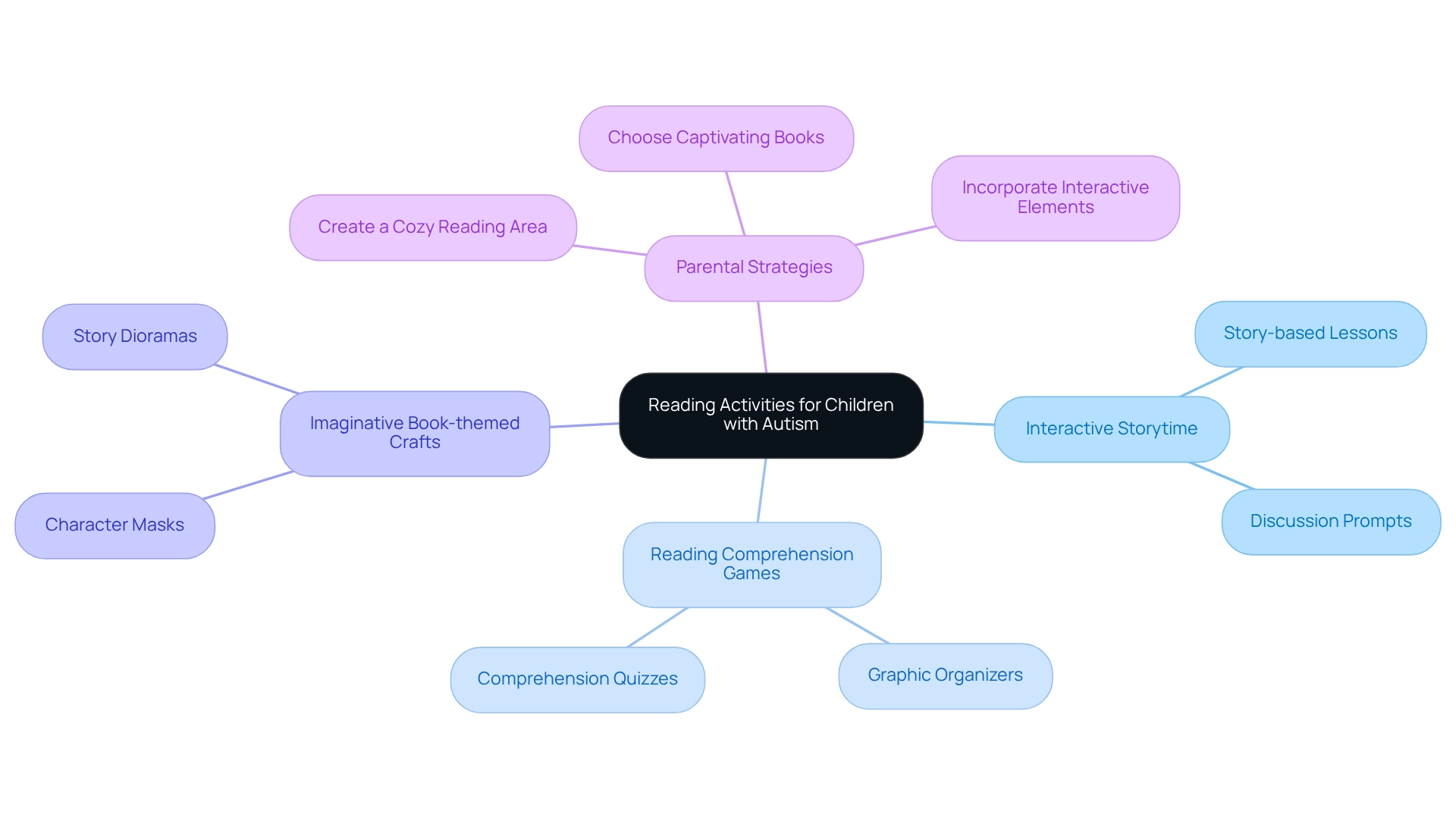
Pathfinders for Autism: Technology-Based Activities for Engagement
At Pathfinders for Autism, we understand the journey of nurturing youth with autism, which is why we provide a range of free autism activities that are technology-driven and designed to engage and inspire. Through interactive learning tools like educational apps, online games, and virtual reality experiences, we aim to make development enjoyable and effective. By embracing technology, children can enhance their communication skills while participating in a modern educational approach.
Research shows that customized mobile interventions can lead to significant improvements in social and cognitive abilities for individuals with autism. Moreover, cultivating Activities of Daily Living (ADL) skills, such as eating and dressing, is crucial for promoting independence. We have seen how educational applications can be particularly effective in this area, with data revealing a notable decrease in the number of dental appointments needed for skill acquisition among young users. This highlights the utility of these tools in fostering independence.
As Jillian Mercado wisely states, "Autism is not the foe; ignorance is." This quote serves as a reminder of the importance of understanding and support in our technology-based endeavors. The impact of technology-driven pursuits continues to grow, making free autism activities essential resources for parents looking to support their children's development. We encourage you to explore these innovative tools and share your experiences with us, as together we can foster a brighter future for our youth.
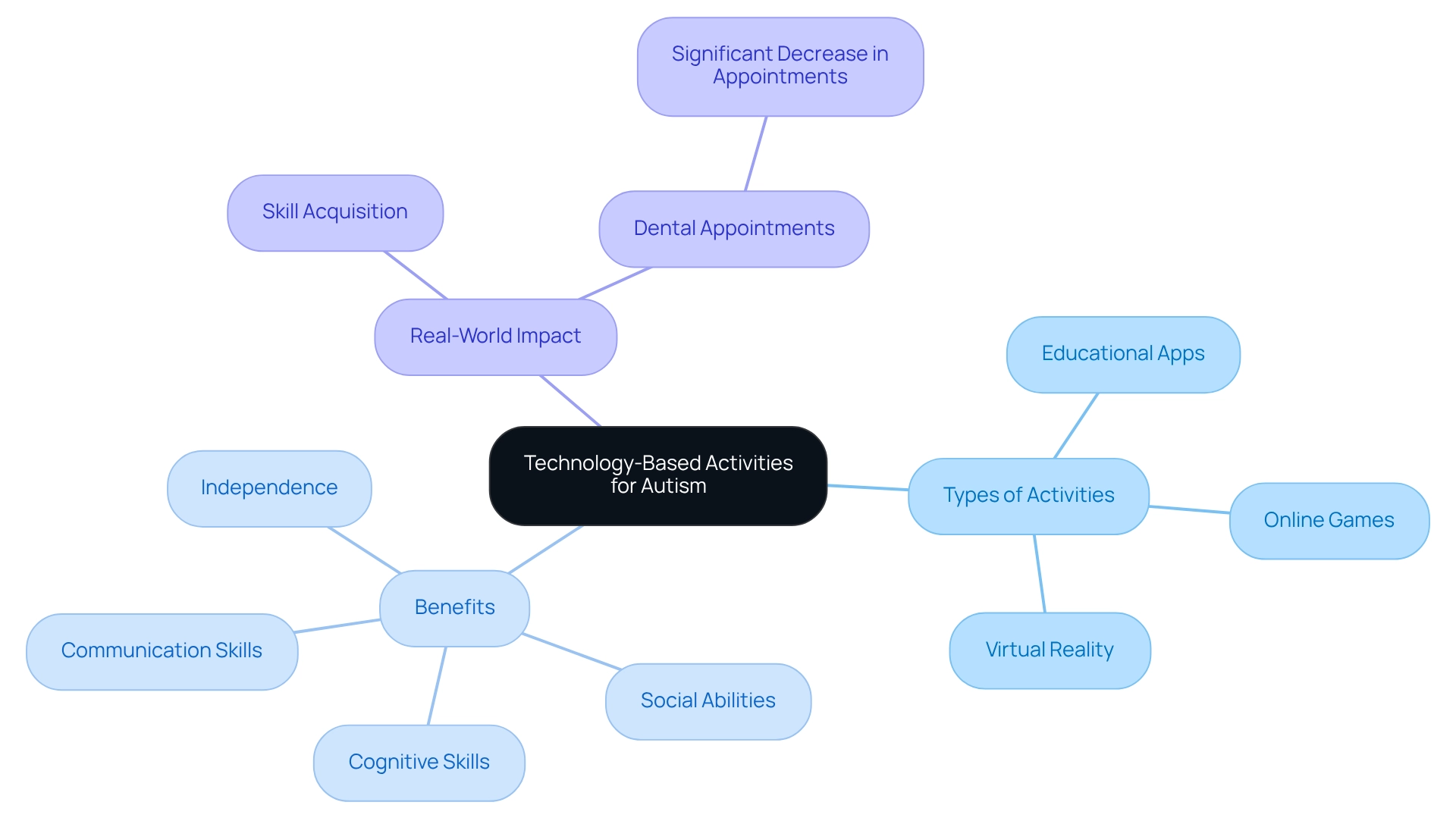
Autism Society: Theater Activities for Creative Expression
The Autism Society passionately advocates for theatrical endeavors that inspire imaginative expression among youth with autism. By participating in free autism activities such as drama workshops, improvisation activities, and performance experiences, these young individuals can uncover their creativity while developing essential social skills. Research shows that participation in theater can significantly enhance self-expression, build confidence, and improve communication abilities. For instance, a study found that 85% of children involved in organized drama activities exhibited increased engagement and improved social interactions.
One heartwarming case study featured a drama workshop where children showcased their talents in a performance, resulting in a remarkable 40% increase in their ability to connect with peers, as noted by their parents. Furthermore, many parents have observed positive changes in their children's interactions with others, which is linked to significant advancements in social skills development through free autism activities like drama workshops. As Mary Barbera insightfully states, 'Embrace the amazing gift of neurodiversity,' underscoring the unique strengths that can be nurtured through creative outlets like theater.
Looking ahead to 2025, the focus on these activities continues to grow, emphasizing their importance in fostering an inclusive environment where young individuals with developmental differences can truly thrive. ASD Media is dedicated to supporting these initiatives by offering resources and strategies that empower parents and professionals to unlock the potential of children with autism through creative expression. Together, let us embrace the transformative power of theater and its ability to enrich the lives of our children.
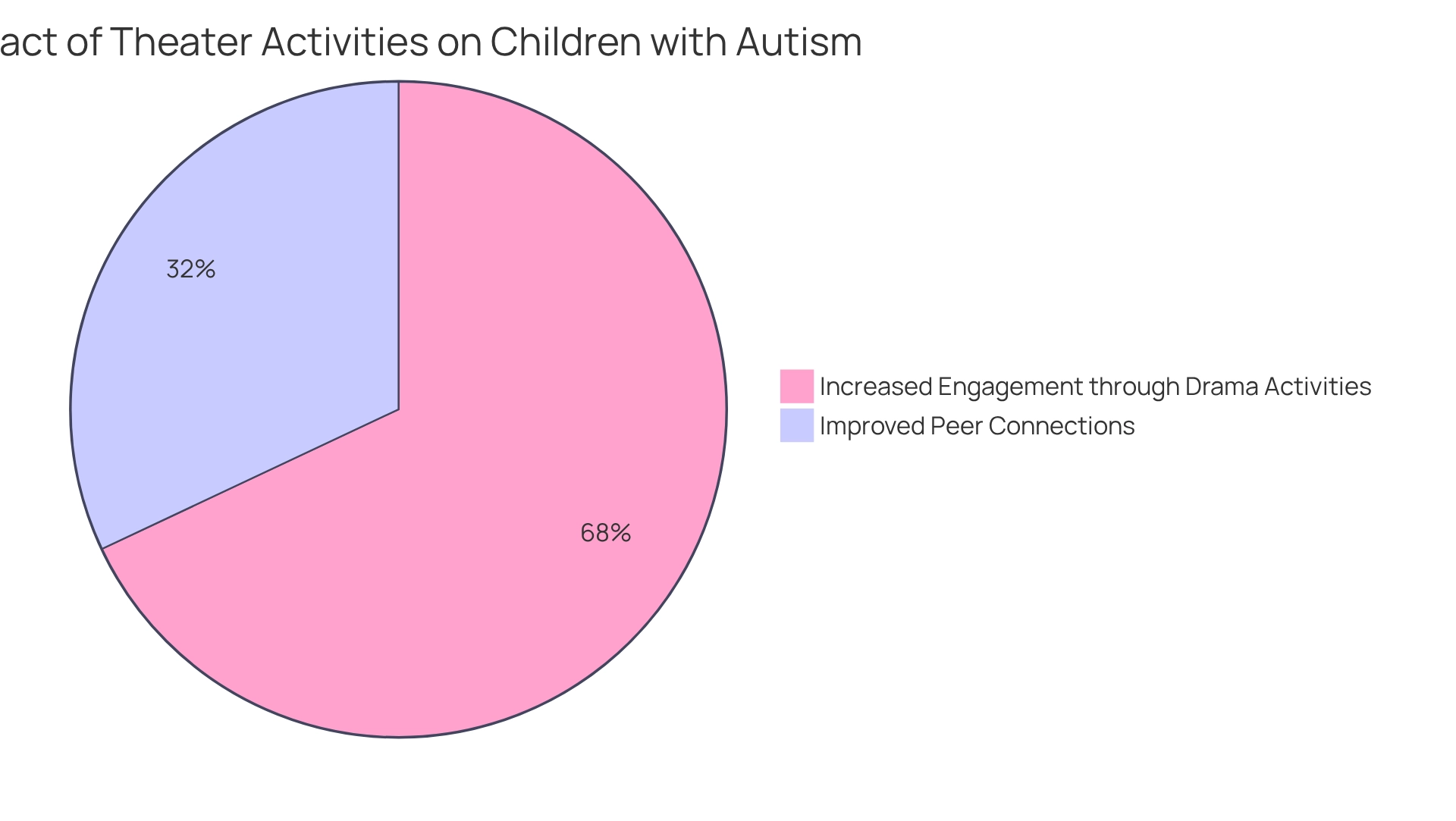
Conclusion
Engaging children with autism through diverse activities and resources is vital for nurturing their development and improving their quality of life. Organizations like ASD Media, Autism Speaks, and the Autism Society lead the way, offering innovative solutions tailored to the unique needs of these children. From interactive virtual learning games to sensory-friendly outdoor activities, these resources not only foster essential skills such as communication and social interaction but also promote self-expression through art, music, and theater.
The impact of these initiatives is profound, empowering families with the tools and support necessary to navigate the complexities of autism. By creating inclusive environments where children can thrive, these organizations highlight the significance of targeted interventions that address diverse communities and individual needs. Whether through technology-based activities, mindfulness practices, or creative expression, each approach presents valuable opportunities for growth and connection.
As families explore these enriching resources, the potential for positive change is tremendous. Supporting children with autism transcends merely addressing challenges; it celebrates their unique strengths and cultivates an environment where they can flourish. Embracing these engaging activities can profoundly influence their lives, paving the way for a brighter future for children on the spectrum.
Frequently Asked Questions
What is the main commitment of ASD Media regarding ABA therapy?
ASD Media is committed to enhancing the application of ABA therapy by providing a comprehensive array of resources aimed at engaging children with developmental disorders.
What statistics highlight the potential for positive growth in children with autism?
A remarkable 78.8% of school-age individuals with autism excel in at least one developmental area by middle childhood, indicating the potential for positive growth through targeted interventions.
What is the average cost of therapeutic behavioral services in the U.S.?
The average cost of therapeutic behavioral services in the U.S. is $175.44.
How does ASD Media support families of children with autism?
ASD Media fosters a nurturing community where individuals can share experiences and learn from one another, ensuring access to best practices and free autism activities.
What role do Board-Certified Behavior Analysts (BCBAs) play in supporting families?
BCBAs provide tailored support that helps families navigate the complexities of treatment, promoting advancement and development for their children.
Why is it important to have inclusive resources for diverse communities?
Disparities in ASD prevalence among various racial groups highlight the need for inclusive resources that cater to diverse communities.
What types of activities does Autism Speaks offer for children with autism?
Autism Speaks offers a variety of free autism activities, including engaging learning games, creative art and crafting sessions, and dynamic movement exercises.
How do virtual resources benefit children with developmental disorders?
Virtual resources significantly boost children's involvement and educational outcomes, providing structured and enjoyable learning experiences from home.
What impact do sensory-friendly events have on children with autism?
Participation in sensory-friendly events can significantly improve social skills development and encourage long-term community engagement for children with autism.
What future goals does the Autism Society of Maryland have for its initiatives?
The Autism Society of Maryland aims to expand its offerings to ensure families have access to meaningful experiences that support their children's growth and development.




